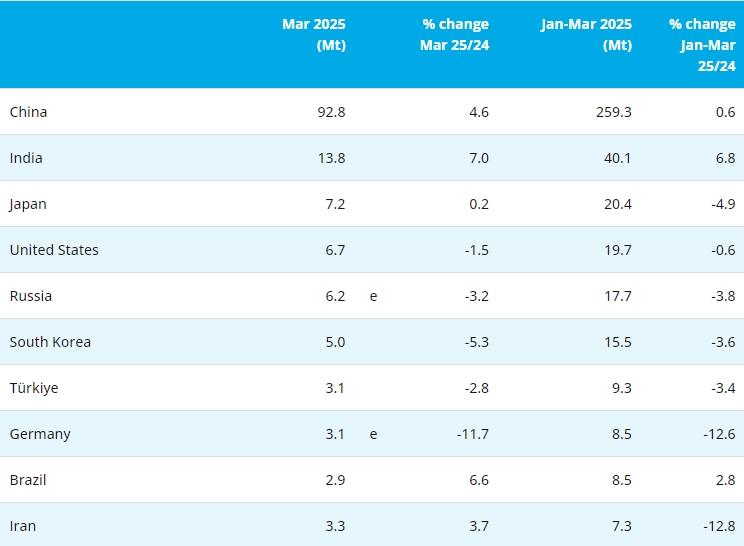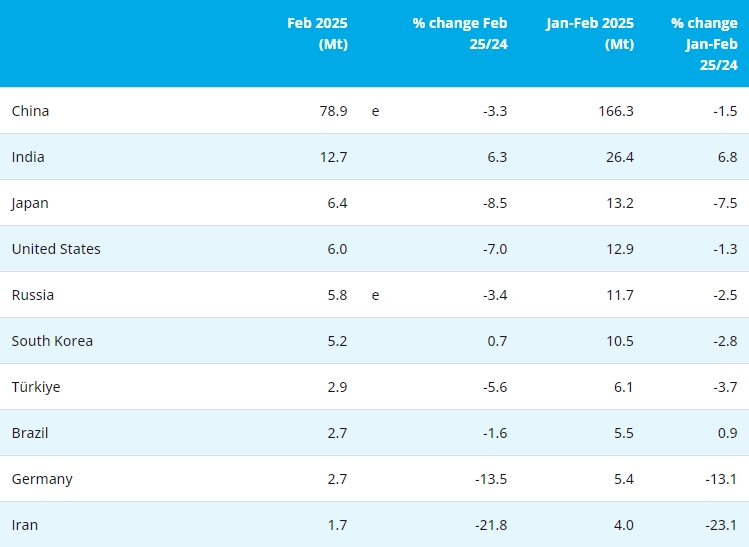
【Ferro-alloys.com】:The scale of new European steel projects focused on bringing on more than 20 million mt of direct-reduced iron capacity using natural gas and hydrogen by 2030 may pressure available iron ore pellet supplies, spurring further innovations while potentially delaying a wider rollout of lower-emission steel.
New DRI and electric arc furnaces that ArcelorMittal, Salzgitter, Voestalpine, and others planned in Germany, Sweden, Spain, and other European countries will depend on scarce low impurity direct reduction-grade pellets, with 20 million mt/year of DRI demand requiring around 30 million mt in pellets. Further growth in DRI plants may be expected next decade, despite many projects yet to achieve final investment decision and funding.
While pellet availability to meet new DRI projects may be tight, markets suggest that current pellet supply can comfortably meet demand into 2024. Pellet premiums in spot markets were weak in 2023, with low premiums for higher silica and alumina blast furnace pellets imported to China from India and other origins.
Contract-grade premiums for higher quality BF and DR pellets were unable to return closer to highs seen last year and in 2021, even with talk of increases for DR pellet premiums agreed for the first quarter. Low premiums also reduced the incentive to invest in beneficiating iron ores to higher pellet specifications.
A mix of weaker European and global steel demand since mid-2022, low steel prices, and margins limited pellet demand. The smaller DR segment benefitted as the overall pellet market loosened. Conversely, global spot reference hard coking coal prices have remained stubbornly high, with Platts Premium Low Vol at above $300/mt FOB Australia through the fourth quarter on limited global supply expansion and spot demand led by India. Prices have trended around double operating costs, boosting miner's margins.
Iron ore supply
Iron ore supply may see limited growth potential outside a handful of existing high-grade projects for global iron ore resources to economically bring on DR-quality feed. This may need innovation in adapting steelmaking processes to remove coal and use lower quality iron ores, as well as putting the onus on ferrous scrap supply—in both volumes and low residual metal grades to meet steel quality and drive steel decarbonization.
US Steel is planning to supply DR-grade pellets from its Keetac taconite ore operation in Minnesota, with specific qualities and shipment schedules yet to be discussed in the market since an earlier end 2023 production target. ArcelorMittal Mining Canada is pivoting to produce DR pellets from its current mix with blast furnace grades following new investments. Even with the change, the Canadian operation would fall well short in meeting ArcelorMittal's DRI project needs.
Other existing pellet suppliers may tweak output and production volumes with investments and licenses, while DRI operators in Algeria plan to expand iron ore processing and pelletizing, investing in dedicated plants and buying in concentrate iron ore from global sources, currently including Mauritania.
Forward DR pellet supply tightness may be exacerbated by the ongoing war in Ukraine affecting iron ore supplies from Ukraine and Russia, new investments in the region, and developing new markets and trade flows ahead of new DRI plants coming online in Europe from around late 2025.
Based on typical blast furnace iron ore burdens in western Europe, pellet demand for DRI may be around three to four times higher, even in cases where lump ore is utilized together with pellets.
For steel producers such as SSAB, Cleveland Cliffs, US Steel, Stelco and other North American blast furnace operators running on 100% pellets, or pellets with hot-briquetted iron and scrap, the difference in demand for pellets with DRI plants may be limited, putting pressure on Europe to find additional volumes. The difference would also depend on DRI quality and usage in EAFs with ferrous scrap and yield efficiencies.
DR quality
The direct reduction route is more sensitive to iron ore quality and market-based iron ore pellet supply will be crucial, according to the International Iron Metallics Association.
The IIMA forecasts a gap in 2033 of around 34 million mt in DR-grade iron ore pellets factoring in demand growth from global DRI plants, in a November presentation. Even with some lower quality blast furnace pellets being used for DRI, the IIMA estimates a remaining gap of 18 million mt—equivalent to around 12 million mt/year of DRI capacity or 5 DRI modules short of feed.
DRI plants cannot use slag to remove impurities and control iron quality, as well as production rates. DRI plants need pellets with low alumina and silica to optimize DRI quality, to limit effects on energy consumption and quality in downstream steelmaking processes.
Outside Europe, existing DRI producers reliant on imported pellets may expand demand, consider new iron ore briquettes and spur on new iron and steel projects with projects to harness renewable power and carbon capture, utilization, and storage.
Major DRI producers in Saudi Arabia, Egypt, the UAE, Algeria, Trinidad & Tobago, and Malaysia, along with new DRI projects in China and Russia, may push iron ore producers to expand further. Investment using lower quality iron ore and the direct reduction of iron ore fines, among other technologies may gather pace after passing tests. South Korea, China, and Japan are eying DRI and EAF investments, with projects to establish lower emissions metallics supply and better utilize scrap and existing blast furnace raw materials and processes in combination with miners BHP, Rio Tinto, and others.
"Increased scrap recycling and mass deployment of innovative technologies are key levers for reducing emissions," the International Energy Agency said in a September report.
- [Editor:Alakay]



 Save
Save Print
Print Daily News
Daily News Research
Research Magazine
Magazine Company Database
Company Database Customized Database
Customized Database Conferences
Conferences Advertisement
Advertisement Trade
Trade













 Online inquiry
Online inquiry Contact
Contact

Tell Us What You Think